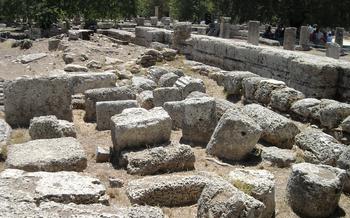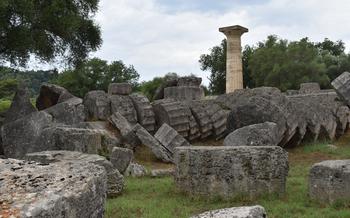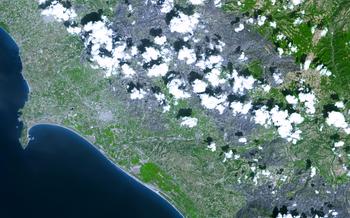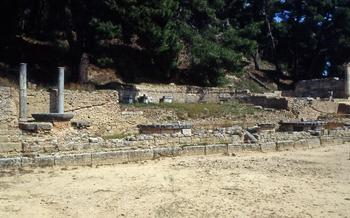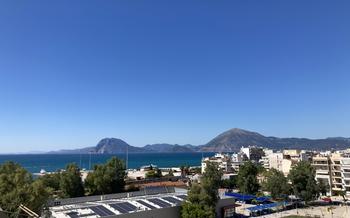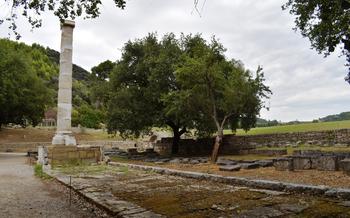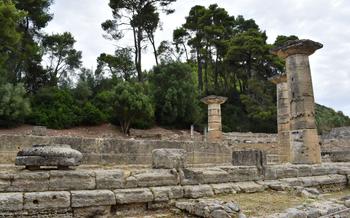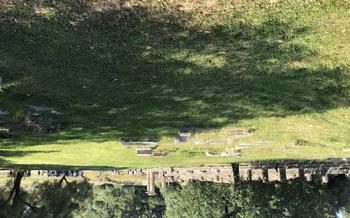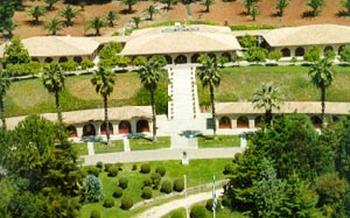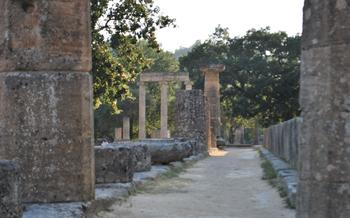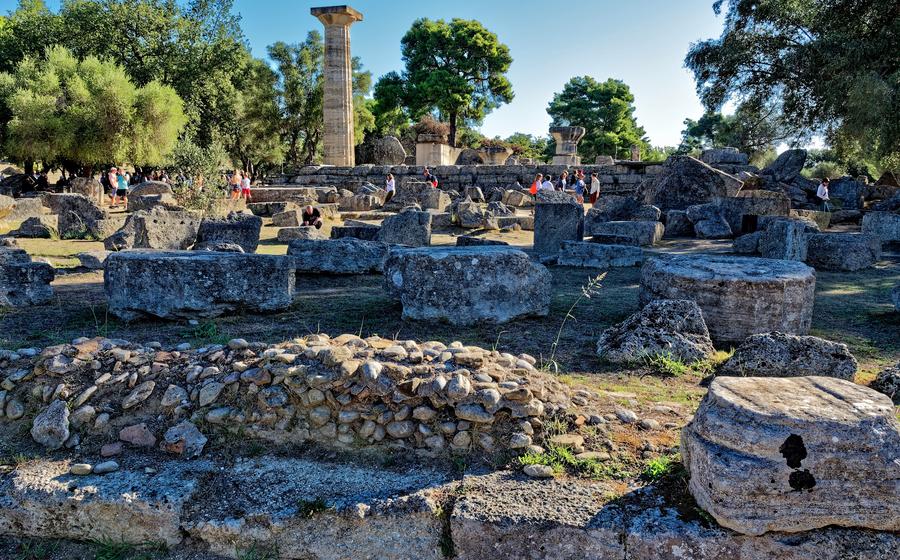
Kotilon
- Unveiling the History of the Kotilon
- Exploring the Archaeological Findings
- The Sacred Rituals of the Kotilon
- The Role of the Kotilon in Ancient Olympia
- Visiting the Kotilon Today
- Highlights of the Kotilon
- The Kotilon Museum
- The Enchanting Surroundings of the Kotilon
- The Kotilon as a Symbol of Ancient Greek Religion
- The Kotilon in Literature and Art
- Preservation and Restoration Efforts
- The Kotilon's Place in Modern-Day Greece
- Insider Tip: Explore the Kotilon at Sunset
Unveiling the History of the Kotilon
The Kotilon holds a significant place in ancient texts, with notable mentions in the works of renowned authors. Pausanias, the Greek traveler and geographer, provides one of the most detailed accounts of the Kotilon. In his book, Description of Greece, Pausanias describes the Kotilon as a sacred grove filled with altars and statues dedicated to various deities. He mentions the Altar of Zeus, the Temple of Hera, and the Statue of Hercules as notable structures within the grove.
Pausanias also sheds light on the role of the Kotilon in the Olympic Games. He writes that the Kotilon served as a training ground for athletes preparing for the games. The grove's proximity to the stadium and other athletic facilities made it an ideal location for athletes to hone their skills and prepare for the competitions.
Over time, the Kotilon underwent changes and additions. During the Roman period, the grove was expanded and embellished with new structures and decorations. These additions reflected the growing importance of the Olympic Games and the desire to enhance the grandeur of the sanctuary. Despite these changes, the Kotilon retained its sacred character and remained a significant part of the religious and athletic traditions of Ancient Olympia.
Exploring the Archaeological Findings
Archaeological excavations at the Kotilon have unearthed a wealth of artifacts that shed light on the religious practices and rituals that took place in this sacred grove. Remains of altars and temples provide evidence of the various deities worshipped here, including Zeus, Hera, and Hercules. Statues and sculptures depicting these deities and other mythological figures adorn the site, offering glimpses into the artistic expressions and beliefs of the ancient Greeks. Inscriptions and dedications found on these artifacts reveal the names of individuals who made offerings and participated in the sacred ceremonies. Archaeological techniques such as excavation, stratigraphic analysis, and artifact conservation have been employed to carefully uncover and preserve these valuable remains, providing insights into the history and significance of the Kotilon.
The Sacred Rituals of the Kotilon
The Kotilon was a sacred place where ancient Greeks performed various religious rituals and ceremonies. These rituals were deeply intertwined with the Olympic Games and were believed to honor the gods and goddesses associated with the sanctuary.
Sacrifices and Offerings:
Sacrifices were an essential part of the rituals performed in the Kotilon. Animals such as bulls, sheep, and goats were sacrificed to the gods as a form of offering. The meat from the sacrifices was then consumed by the participants in the rituals, creating a sense of communion between the divine and the mortal.
Libations and Prayers:
Libations, or the pouring of liquids as an offering to the gods, were another common practice in the Kotilon. Participants would pour wine or water onto the ground or into sacred vessels, accompanied by prayers and invocations to the deities. These libations were believed to appease the gods and bring their favor.
Processions and Ceremonies:
Processions were a prominent feature of the rituals conducted in the Kotilon. Participants would form processions and march through the sacred grove, carrying statues of the gods, offerings, and other ritual objects. These processions were accompanied by music, singing, and chanting, creating a festive and reverent atmosphere.
Religious Significance:
The rituals performed in the Kotilon held deep religious significance for the ancient Greeks. They believed that these rituals ensured the gods' favor and protection, bringing success and prosperity to the community. The rituals also strengthened the bond between the people and their deities, fostering a sense of unity and shared religious beliefs.
The Role of the Kotilon in Ancient Olympia
The Kotilon played a crucial role in the ancient sanctuary of Olympia, primarily associated with the Olympic Games, the most significant athletic and religious festival in the ancient Greek world. It served as a venue for various athletic events, including wrestling, boxing, and the pentathlon. The Kotilon's proximity to the stadium and other sports facilities made it an ideal location for athletes to train and prepare for the competitions.
Moreover, the Kotilon held religious significance as a sacred precinct within the sanctuary. It was believed to be the birthplace of Hercules, the legendary hero and demigod, and was associated with Zeus, the king of the gods, and his wife Hera. The presence of temples, altars, and statues dedicated to these deities further emphasized the religious importance of the Kotilon.
Additionally, the Kotilon served as a gathering place for athletes, officials, and spectators during the Olympic Games. It was here that athletes would take their oaths of fair play and make sacrifices to the gods before competing. The Kotilon was also a place where visitors could socialize, exchange ideas, and celebrate the Olympic spirit.
Visiting the Kotilon Today
The Kotilon lies within the archaeological site of Olympia, a UNESCO World Heritage Site, and is accessible to visitors year-round. Wander through the ancient ruins, marveling at the well-preserved remains of altars, temples, and statues. Embark on a guided tour to gain insights into the history, mythology, and significance of this sacred grove. Alternatively, explore at your own pace, immersing yourself in the atmosphere of this ancient sanctuary. Plan your visit during the shoulder seasons (spring and fall) to avoid the summer crowds and enjoy a more intimate experience.
Highlights of the Kotilon
While exploring the Kotilon, visitors can marvel at several notable structures and artifacts that provide a glimpse into the site's rich history and religious significance.
The Altar of Zeus, an imposing structure dedicated to the king of the gods, stands as a testament to the Kotilon's religious importance. The Temple of Hera, dedicated to Zeus's wife and sister, is another significant structure that showcases the site's connection to the Olympian deities.
One of the most iconic artifacts discovered in the Kotilon is the Statue of Hercules, the legendary hero who was born in the sacred grove. This impressive sculpture captures the strength and determination of Hercules, embodying the ideals of ancient Greek mythology.
In addition to these highlights, visitors can explore other notable structures and artifacts, including the remains of a gymnasium and a palaestra, where athletes trained for the Olympic Games, and various statues, inscriptions, and dedications that provide insights into the lives and beliefs of the ancient Greeks.
The Kotilon Museum
The Kotilon Museum, situated within the archaeological site, is a repository of knowledge and artifacts that provide a deeper insight into the history and significance of the Kotilon. As you step into the museum, you'll be greeted by an array of exhibits that chronologically narrate the story of this sacred grove, from its earliest origins to its role in the Olympic Games and beyond.
Discover an impressive collection of artifacts unearthed during excavations at the Kotilon. These include fragments of sculptures, pottery shards, inscriptions, and dedications that offer clues to the religious practices and rituals that took place in this sacred space. Interactive displays and educational resources bring the ancient world to life, allowing visitors to engage with the site's history in a dynamic and immersive way.
Learn about the significance of the Kotilon in Greek mythology, its connection to the Olympic Games, and its role as a training ground for athletes. The museum also sheds light on the evolution of the site over time, from its humble beginnings to its transformation into a monumental sanctuary.
Plan your visit to the Kotilon Museum to delve deeper into the mysteries of this sacred grove. Its exhibits and displays will enhance your understanding of the Kotilon's role in ancient Greek religion and culture, providing a comprehensive overview of this fascinating archaeological site.
The Enchanting Surroundings of the Kotilon
The Kotilon is not only a sacred site of great religious significance but also a place of natural beauty and tranquility. The Alpheus River, with its crystal-clear waters, meanders through the valley, creating a serene and picturesque landscape. The Kronion Hill, a forested hilltop overlooking the sanctuary, offers breathtaking views of the surrounding countryside. The Peloponnese countryside, with its rolling hills, lush vineyards, and olive groves, provides a stunning backdrop to the ancient site.
Visitors to the Kotilon can take advantage of the beautiful surroundings by embarking on nature walks or hikes. Several trails wind through the area, allowing visitors to explore the region's natural beauty and discover hidden gems such as secluded waterfalls or ancient ruins. The combination of historical significance and natural splendor makes the Kotilon a truly unique and unforgettable destination.
The Kotilon as a Symbol of Ancient Greek Religion
The Kotilon offers a glimpse into the religious beliefs and practices of the ancient Greeks. It was a sacred space dedicated to the worship of Zeus and Hera, the king and queen of the Olympian gods. Here, rituals and ceremonies were performed to honor these deities and seek their favor. Through the archaeological remains, we can understand the significance of religious practices in ancient Greek society.
The Kotilon provides insights into the ancient Greek worldview, where gods were believed to be actively involved in human affairs. The rituals and offerings made at the Kotilon were a way for the ancient Greeks to connect with the divine and influence their fate. This sacred grove represents the deep religious beliefs that shaped ancient Greek culture.
Comparing the Kotilon to other religious sites, such as the Oracle of Delphi or the Acropolis in Athens, highlights the diversity and complexity of ancient Greek religion. Each site served a specific purpose and was associated with different deities and rituals. The Kotilon, with its focus on Zeus and Hera, represents a significant aspect of the ancient Greek religious landscape.
The Kotilon in Literature and Art
The Kotilon's significance extends beyond archaeology, finding its way into the realm of literature and art. In ancient Greek literature, the Kotilon is mentioned in Homer's epic poems, the Iliad and the Odyssey, as well as in the works of Pindar and other poets. These references highlight the Kotilon's religious and mythological importance in ancient Greece.
In modern times, the Kotilon has captured the imagination of writers and artists, serving as a source of inspiration for their creative works. The renowned Greek poet Constantine Cavafy penned a poem titled "The Kotilon," which evokes the site's ancient atmosphere and its connection to Greek mythology. The Kotilon has also been featured in novels, short stories, and plays, capturing the attention of readers worldwide.
Beyond literature, the Kotilon has also made its mark in the visual arts. Depictions of the sacred grove can be found in ancient Greek pottery, sculptures, and mosaics. In modern times, artists have continued to draw inspiration from the Kotilon, creating paintings, sculptures, and other artworks that evoke its beauty and significance.
The Kotilon's presence in literature and art underscores its enduring cultural impact, reaching beyond the confines of archaeological research to captivate the imaginations of people across time and cultures.
Preservation and Restoration Efforts
The Kotilon, a site of immense historical and archaeological significance, requires ongoing conservation and restoration efforts to protect its ancient remains and preserve its cultural heritage. These efforts involve a range of activities, primarily aimed at safeguarding the site from natural elements, preventing further deterioration, and ensuring its accessibility to visitors.
Archaeologists and conservators work diligently to stabilize and repair the structures, restore damaged artifacts, and document the site's evolution through meticulous research and documentation. Challenges arise due to the age and fragility of the remains, as well as the impact of natural disasters and human activity.
The Kotilon's preservation is not merely about maintaining physical structures; it is about preserving the invaluable knowledge and insights they hold. Archaeological research and documentation play a crucial role in understanding the site's significance, deciphering its stories, and ensuring that its legacy endures for future generations.
Preserving the Kotilon is not just a technical endeavor; it is an act of cultural stewardship. By protecting this sacred grove, we honor the ancient Greek civilization that created it, acknowledging its enduring influence on our understanding of history, religion, and mythology.
The Kotilon's Place in Modern-Day Greece
The Kotilon holds a profound significance for the people of modern-day Greece, serving as a symbol of their rich history and cultural identity. The site is revered as a source of local pride, and its preservation and promotion are of utmost importance to the region. The Kotilon's integration into the tourism industry has allowed visitors to witness the grandeur of this ancient sanctuary, while also contributing to the sustainable development of the region. By promoting cultural heritage and responsible tourism, the Kotilon plays a vital role in preserving Greece's rich legacy while ensuring its accessibility to future generations.
Insider Tip: Explore the Kotilon at Sunset
To truly embrace the magic of the Kotilon, I highly recommend visiting the site at sunset. As the golden orb dips below the horizon, the entire sanctuary is bathed in a warm, ethereal glow, casting an enchanting spell on the ancient ruins. The atmosphere becomes serene and contemplative, inviting you to immerse yourself in the site's rich history and spiritual significance. Moreover, the softer light of dusk is ideal for photography enthusiasts seeking to capture the beauty of the Kotilon in all its glory. By avoiding the midday heat and crowds, you'll have the unique opportunity to experience the site's tranquility and connect with its ancient spirit in a profound way.
